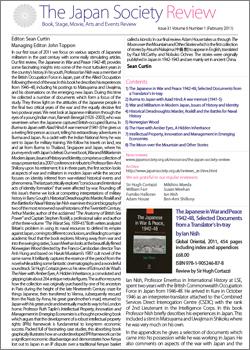Issue 31 (February 2011, Volume 6, Number 1)

In our first issue of 2011 we focus on various aspects of Japanese militarism in the past century with some really stimulating articles.
Our first review, The Japanese in War and Peace 1942-48, provides some fascinating insights into some of the most turbulent years in the country’s history. In his youth, Professor Ian Nish was a member of the British Occupation Force in Japan, part of the Allied Occupation following the end of the war. In this book he describes his experiences from 1946–48, including his postings to Matsuyama and Uwajima, and his observations on the emerging new Japan. During this time he collected a number of documents which form a focus of the study. They throw light on the attitudes of the Japanese people in the final two critical years of the war and the equally decisive first two postwar years.
We next look at Japanese militarism through the eyes of a young Indian man, Ramesh Benegal (1926 -2003), who was seventeen when the Japanese captured British-occupied Burma. In Burma to Japan with Azad Hind: A war memoir (1941-5) he gives us a riveting first-person account, telling his extraordinary adventures in Burma and Japan. As a cadet with the Indian National Army he was sent to Japan for military training. We follow his travels on land, sea and air from Burma to Thailand, Singapore and Japan, where his journey ends with Japan’s defeat.
Our next book, War and Militarism in Modern Japan, Issues of History and Identity, comprises a collection of essays presented at a 2007 conference in tribute to Professor Ben-Ami Shillony upon his retirement. It is in three parts, the first section looks at aspects of war and militarism in modern Japan while the second focuses on identity inferred from war-related historical events and phenomena.The last part critically explores “conscious and intentional acts of identity formation” that were affected by war.
Rounding off this issue’s theme we look at competing interpretations of military history in Barry Gough’s Historical Dreadnoughts: Marder, Roskill and the Battles for Naval History. Ian Nish examines this joint biography of two of the most renowned naval historians of the Twentieth Century, Arthur Marder, author of the acclaimed “The Anatomy of British Sea Power” and Captain Stephen Roskill, a professional sailor and author of the three-volume “The War at Sea, 1939-45.” Both writers analyzed Britain’s problem in using its naval resources to defend its empire against Japan, coming to different conclusions, and leading to a major academic feud that the book explores.
Moving away from war and into the swinging sixties, Susan Meehan looks at the beautifully filmed Norwegian Wood directed by the Franco-Cambodian director Tran Anh Hung and based on Haruki Murakami’s 1987 cult novel of the same name. It brilliantly captures the essence of the period from the novel while adding some fantastic cinematography and a wonderful soundtrack.
Sir Hugh Cortazzi gives us his view of Edmund de Waal’s The Hare with Amber Eyes, A Hidden Inheritance, a convoluted and gripping tale about 264 antique netsuke figures. The author recounts how the collection was originally purchased by one of his ancestors in Paris during the height of the late Nineteenth Century craze for things Japanese, then transferred to Vienna, subsequently rescued from the Nazis by Anna, his great grandmother’s maid, returned to Japan with his great uncle and eventually made its way to his London home.
Professor Ruth Taplin’s Intellectual Property, Innovation and Management in Emerging Economies is a thought-provoking book which argues that the development of a robust intellectual property rights (IPRs) framework is fundamental to long-term economic success. Packed full of fascinating case studies, this absorbing book graphically illustrates how an underdeveloped IPR framework can be a significant economic disadvantage and demonstrates how Kenya lost out to Japan in an IP dispute over a traditional Kenyan basket called a kiondo.
In our final review Adam House takes us through The Moon over the Mountain and Other Stories which is the first collection of stories by Atsushi Nakajima (中島 敦) to appear in English, translated by Paul McCarthy and Nobuko Ochner. The stories were originally published in Japan in 1942-1943 and are mainly set in ancient China.
Contents
- The Japanese in War and Peace 1942-48, Selected Documents from a Translator’s In-tray
- Burma to Japan with Azad Hind: A war memoir (1941-5)
- War and Militarism in Modern Japan, Issues of History and Identity
- Historical Dreadnoughts: Marder, Roskill and the Battles for Naval History
- Norwegian Wood
- The Hare with Amber Eyes, A Hidden Inheritance
- Intellectual Property, Innovation and Management in Emerging Economies
- The Moon over the Mountain and Other Stories
Contributors
Editor
Sean Curtin
Managing Editor
John Toppon
Reviewers
Sir Hugh Cortazzi, Ian Nish, Susan Meehan, Sean Curtin and Adam House

